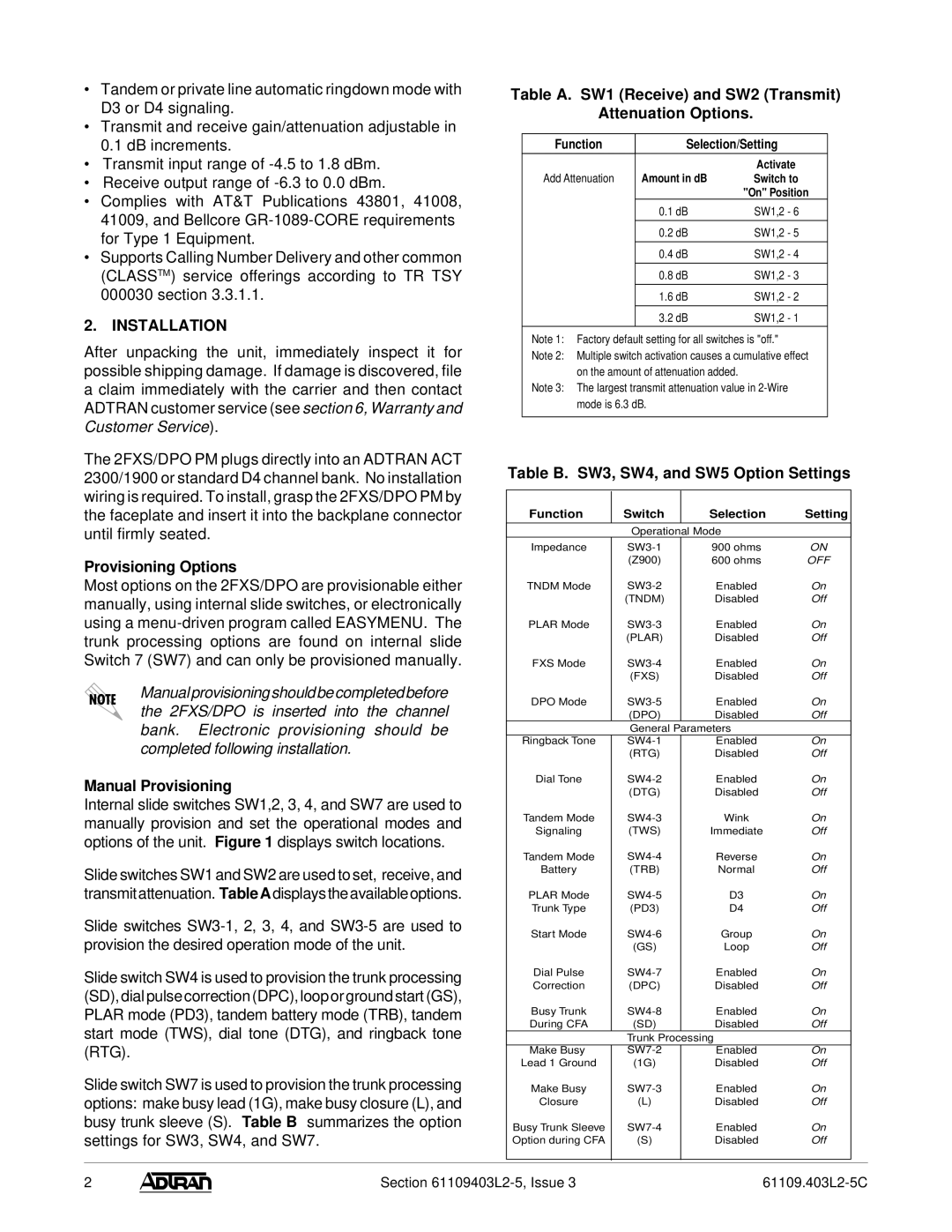
•Tandem or private line automatic ringdown mode with D3 or D4 signaling.
•Transmit and receive gain/attenuation adjustable in 0.1 dB increments.
•Transmit input range of
•Receive output range of
•Complies with AT&T Publications 43801, 41008, 41009, and Bellcore
•Supports Calling Number Delivery and other common (CLASSTM) service offerings according to TR TSY 000030 section 3.3.1.1.
2. INSTALLATION
After unpacking the unit, immediately inspect it for possible shipping damage. If damage is discovered, file a claim immediately with the carrier and then contact ADTRAN customer service (see section 6, Warranty and Customer Service).
The 2FXS/DPO PM plugs directly into an ADTRAN ACT 2300/1900 or standard D4 channel bank. No installation wiring is required. To install, grasp the 2FXS/DPO PM by the faceplate and insert it into the backplane connector until firmly seated.
Provisioning Options
Most options on the 2FXS/DPO are provisionable either manually, using internal slide switches, or electronically using a
Manualprovisioningshouldbecompletedbefore the 2FXS/DPO is inserted into the channel bank. Electronic provisioning should be completed following installation.
Manual Provisioning
Internal slide switches SW1,2, 3, 4, and SW7 are used to manually provision and set the operational modes and options of the unit. Figure 1 displays switch locations.
Slide switches SW1 and SW2 are used to set, receive, and transmitattenuation. Table A displaystheavailableoptions.
Slide switches
Slide switch SW4 is used to provision the trunk processing (SD), dial pulse correction (DPC), loop or ground start (GS), PLAR mode (PD3), tandem battery mode (TRB), tandem start mode (TWS), dial tone (DTG), and ringback tone (RTG).
Slide switch SW7 is used to provision the trunk processing options: make busy lead (1G), make busy closure (L), and busy trunk sleeve (S). Table B summarizes the option settings for SW3, SW4, and SW7.
Table A. SW1 (Receive) and SW2 (Transmit)
Attenuation Options.
Function | Selection/Setting | ||
|
| Amount in dB | Activate |
Add Attenuation | Switch to | ||
|
|
| "On" Position |
|
| 0.1 dB | SW1,2 - 6 |
|
|
|
|
|
| 0.2 dB | SW1,2 - 5 |
|
|
|
|
|
| 0.4 dB | SW1,2 - 4 |
|
|
|
|
|
| 0.8 dB | SW1,2 - 3 |
|
|
|
|
|
| 1.6 dB | SW1,2 - 2 |
|
|
|
|
|
| 3.2 dB | SW1,2 - 1 |
Note 1: | Factory default setting for all switches is "off." | ||
Note 2: | Multiple switch activation causes a cumulative effect | ||
| on the amount of attenuation added. |
| |
Note 3: | The largest transmit attenuation value in | ||
| mode is 6.3 dB. |
| |
|
|
|
|
Table B. SW3, SW4, and SW5 Option Settings
Function | Switch | Selection | Setting |
|
|
|
|
| Operational Mode |
| |
Impedance | 900 ohms | ON | |
| (Z900) | 600 ohms | OFF |
TNDM Mode | Enabled | On | |
| (TNDM) | Disabled | Off |
PLAR Mode | Enabled | On | |
| (PLAR) | Disabled | Off |
FXS Mode | Enabled | On | |
| (FXS) | Disabled | Off |
DPO Mode | Enabled | On | |
| (DPO) | Disabled | Off |
| General Parameters |
| |
Ringback Tone | Enabled | On | |
| (RTG) | Disabled | Off |
Dial Tone | Enabled | On | |
| (DTG) | Disabled | Off |
Tandem Mode | Wink | On | |
Signaling | (TWS) | Immediate | Off |
Tandem Mode | Reverse | On | |
Battery | (TRB) | Normal | Off |
PLAR Mode | D3 | On | |
Trunk Type | (PD3) | D4 | Off |
Start Mode | Group | On | |
| (GS) | Loop | Off |
Dial Pulse | Enabled | On | |
Correction | (DPC) | Disabled | Off |
Busy Trunk | Enabled | On | |
During CFA | (SD) | Disabled | Off |
| Trunk Processing |
| |
Make Busy | Enabled | On | |
Lead 1 Ground | (1G) | Disabled | Off |
Make Busy | Enabled | On | |
Closure | (L) | Disabled | Off |
Busy Trunk Sleeve | Enabled | On | |
Option during CFA | (S) | Disabled | Off |
|
|
|
|
2 |
| Section |
